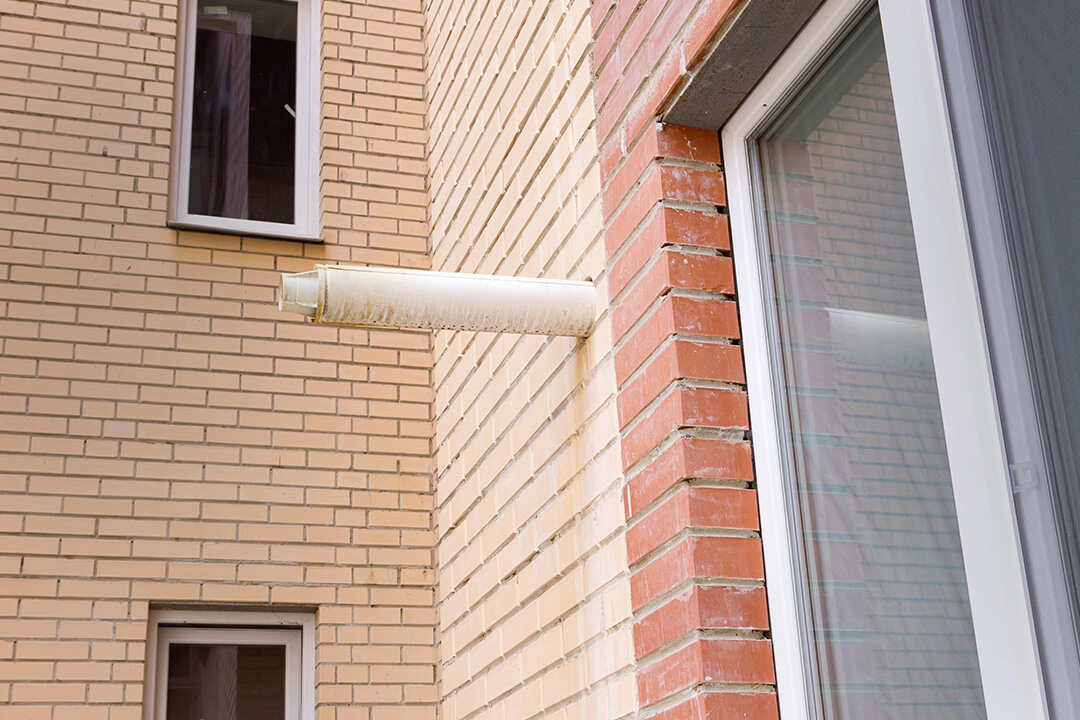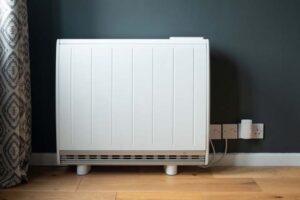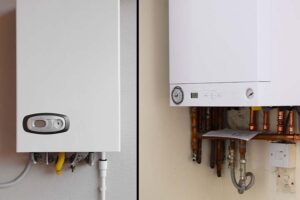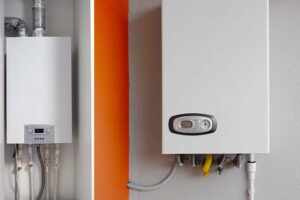Insulating the condensate pipe in a boiler is a safety step. To do that, unique insulation materials must be wrapped around the discharge pipe of a boiler. This pipe, which is necessary for a condensing boiler system, moves the acidic water that is made when the boiler heats water. Along with that, it can freeze in cold weather.
Insulation keeps the temperature inside the pipe stable, which stops freeze-ups and possible clogs. It will keep your boiler better and increase its lifespan. Because of this, proper protection of your condensate pipes is very important for keeping your boiler running smoothly, especially during the winter.
One main reason to insulate cold or chilled pipes with boiler condensate pipe insulation is to keep condensation from forming. Have you ever seen a tunnel for cold liquid that wasn’t protected in the summer? It looks like the pipe leaks everywhere, making you think of the old saying, “The pipe is sweating.” Read on to understand everything about boiler condensate pipe insulation.
What is a Boiler Condensate Pipe?
The condensate pipe is integral to transferring acidic wastewater from your boiler to the drains outside your home.
When the temperature starts to drop, it’s normal for the innards of the pipe to freeze. As it causes a blockage and resulting in the boiler totally shutting down.
Most of the best condensing combi boilers have a unique error code that suggests a frozen condensation pipe. The code will be shown on the screen.
Importance of Boiler Condensate Pipe Insulation
Freeze Protection: The UK is no stranger to cold spells, and when temperatures plunge, un-insulated pipes may freeze, forcing your heating system to shut down. Insulation functions as a thermal blanket, lowering the danger of freezing.
Noise Reduction: If you’ve ever been bothered by the sound of water trickling downpipes. Thus, insulation may be your quiet saviour, silencing those bothersome sounds.
Longer Pipe Lifespan: Insulation of boiler condensate pipe protects them from the weather and decreases wear and tear. And it adds years to their service life.
Why Is Pipe Condensation Bad?
Whatsoever! A small amount of water on the pipe may never do any damage. Think again.
Pipe Corrosion: Condensation on the metal pipe causes rust to the surface of the piping. The wetness on the pipe mixes with oxygen and electrons, resulting in premature rusting and rust. The rust will finally lead to leaks in the plumbing and pipe joints.
Mold Growth: Moisture offers the lifeblood for mold particles and cells to develop on painted pipes, insulation, and simply plain dust/dirt on piping. This mould growth may spread through polluted drips dripping off pipes onto the floor, equipment, walls, etc.
Safety Issues: Dripping water from ceiling lines can cause big puddles in work areas. It can be a potential safety risks. Employees may slip and fall due to the extra wetness buildup on slippery floor surfaces.
Water Damage: The extra wetness of a “sweating pipe” will build up over time. That results in puddles on the floor or damage to walls, ceiling tiles, insulation, and flooring (in finished areas). When you see brown spots on the ceiling tiles of an office. A roofing leak does not cause it. It’s most likely condensation caused by uninsulated pipe or HVAC ducts.
What Causes A Pipe To "Condense"?
“Pipe sweat,” or condensation, is made when hot-humid air hits the cold bare surface of a cold pipe. Just like a glass of ice water will condense on a hot summer day, pipe sweat is the same concept. The temperature of the pipe can be warmer than you may think. As long as the pipe is below the Dew Point Temperature, the pipe will evaporate.
Dew Point Temperature: The dew point is the temperature at which the moisture in the air turns into liquid or ice. If the surface temperature of an object goes below the dew point, water will form or “condense” on the object’s surface.
How to Control Pipe Condensation with Insulation?
Proper Wall Thickness
There are two main factors when covering a pipe with known leakage problems. First of all, check the insulation thickness is adequate to halt the accumulation of condensation. A big misunderstanding about insulation and humidity avoidance is that any amount of insulation will work. This needs to be fixed, as the top temperature of the insulation itself may still fall below the DPT – Dew Point Temperature. The insulation wall thickness must be thick enough to raise the surface temperature above the Dew Point Temperature. The wall thickness estimate includes the following items:
- Operating Temperature of the Pipe Itself
- Ambient Air Temperature in Worst Case Scenario
- Ambient Relative Humidity (%)
- Wind Speed (if relevant in outdoor uses)
Choosing The Right Insulation Material
When choosing the best insulation material, consider the position of the pipe, your income, and desired results.
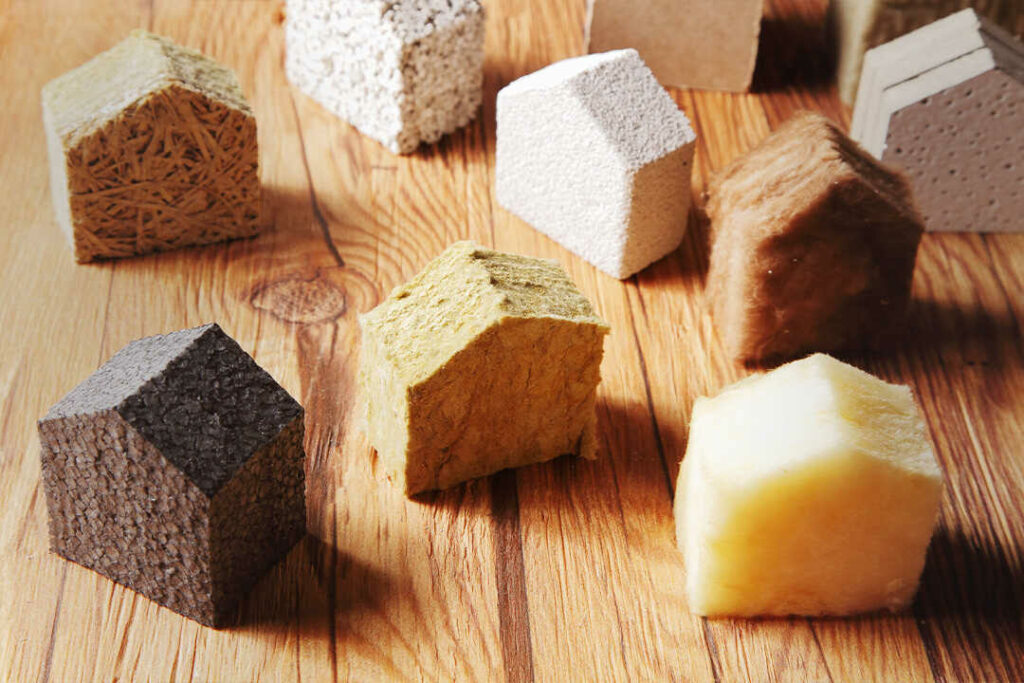
Foam Insulation Tubes
These are popular due to their easy placement. They act like a jacket, slipping over your pipes. They’re cheap and efficient, ideal for most UK houses.
Fibreglass Envelops
It is perfect but can be complex to install. These wraps are wound around the pipe and offer incredible sound protection.
Rubber Insulation
Durable and slightly more strong than foam, rubber insulation is excellent for lines at risk of damage.
Tools And Materials Required
Before insulating, ensure you have the correct tools on hand:
- Chosen insulation material (foam, fiberglass, or rubber)
- Knife or scissors
- Tape measure
- PVC or aluminium tape or zip ties
- Safety goggles & gloves (especially if using fibreglass)
Vapour Barrier
Once you have adequately determined the right insulating wall thickness, the next element to consider is the Vapour Barrier (sometimes referred to as a Moisture Barrier). The Vapour Barrier stops water vapour, or humid air, from permeating the insulation and contacting the pipe. Maintaining a Vapour Barrier across the whole pipe insulation system is crucial to avoiding condensation and insulation degradation. Fibreglass Pipe Insulation pertains to a pre-installed Vapour Barrier. It is a white paper jacket called an ASJ (All-Service Jacket).
The ASJ jacket has an SSL (Self-Sealing Lap), which closes the vapour barrier at the 3ft seams. Buy Insulation Products supplies “butt strips,” which are 3″ wide strips of tape that are put across the butting junction of two lengths of fibreglass pipe insulation. If sealed effectively, the vapour barrier will be maintained to avoid condensation. One significant difficulty location is pipe fittings (90°/45° elbows, tees, etc.). The insulator must pay particular attention to sealing the PVC fitting covers to the fibreglass pipe insulation. Sealing the junction between the PVC cover and the pipe insulation using PVC Vinyl Tape is vital to limit air penetration in the issue region.
Classify Pipe Insulation To Reduce Damage
When adding fibreglass pipe insulation to a pipe that has been detected or suspected of condensation, We highly advise incorporating the new insulating system into sections. Basically this indicates that we separate the pipe insulation into little segments to prevent degradation of larger sections of insulation caused by moisture incursion. We may do this by sealing the margins of fibreglass pipe insulation using CP-11 mastic to make the edges of the sections water-resistant. Sealing the fiberglass pipe insulation with mastic is necessary for PVC fitting covers. Both sides of the fibreglass pipe insulation of a 90° elbow cover should be sealed with mastic to the pipe.
The Key Benefits of Boiler Condensate Pipe Insulation
Energy Costs | Insulation of boiler condensate pipes considerably minimises heat loss around pipes. It also serves as a moisture barrier. It leads to greater thermal performance and increased operational economies. That may decrease operational expenditures. It also helps you save money by lowering your total energy use. |
Frozen Pipes | When your pipes are uninsulated, freezing temperatures may be a severe worry. When the mercury dips, water left in the pipes situated outdoors or in unheated regions where the ambient temperature might drop below the freezing point may freeze and expand. It may develop microscopic fractures that break open or rupture the pipe completely. The extra insulation expense is modest compared to the cost of restoring damages caused by a burst pipe. Thus, it is vital to insulate piping, especially in places prone to sub-zero temperatures. |
Condensation Damage | When uninsulated or inadequately insulated pipes operate below ambient temperatures. Water vapour can start to settle on the pipe surface. Moisture is recognised to be the primary cause of many different forms of corrosion. So, avoiding condensation on piping is vital. Condensation may also speed up pipe corrosion, erosion, leaks, fractures, and gaps. By adding some additional insulation to the pipes, you can considerably minimise the chance of damage from burst pipes and corrosion. |
Prevent Damages | Suppose a human gets in touch with an excessively hot or cold conduit that is left uninsulated. They will likely be wounded. Ideally, hot water pipes should be insulated from the water boiler to their ultimate destination. So, insulation is a key to preventing damage. |
Reduces Heat Loss | Covering hot water lines reduces the heat lost between the water heater and the faucet. That will boost the temperature of the water given to the faucet, showerhead, or washing machine. When the temperature of the water provided is greater, you may switch your water heater down by a few notches. Therefore, it decreases the temperature of your water heater by 10 degrees. This way, you may lower your energy bills by 3-5 percent. |
Acoustic Insulation | When pipes are used, they might vibrate and even make banging noises. Pipe insulation may help absorb these high-pitched operating sounds. |
Conclusion
Insulating your condensate pipe is a preventative method for home upkeep. Not only will it keep your condensing boiler working well. This can prevent you from a cold home during a cold snap. But it can also lower noise and save you money in the long run by stopping emergency callouts. And it will also increase the life of your pipe.
Following our above guide on ‘boiler condensate pipe insulation,’ you will get the safety of your condensate pipe. As well as it needs to serve your home properly for years. And when winter rolls around, you’ll have one less thing to think about.
Many pipe insulation materials provide great heat insulation, fire safety and sound insulation while staying cost-effective. Select the best pipe insulation for your home. And improve the life of your pipes while making your home more energy-efficient.


